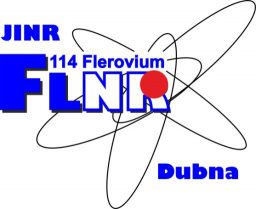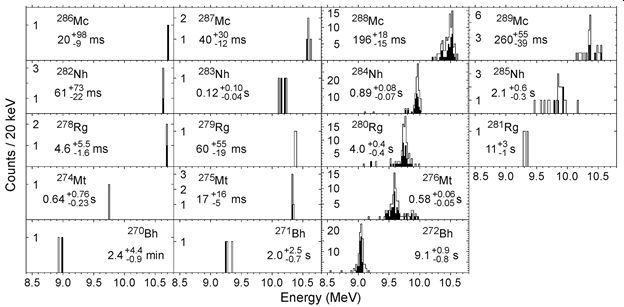Update on the experiments at the SHE Factory
N.Kovrizhnykh
The 55th meeting of the PAC for Nuclear Physics
January 27, 2022
In 2021, three series of experiments were performed at the new gas-filled separator DGFRS-2 of the Superheavy Element Factory, FLNR, JINR. The fusion reactions of 243Am, 242Pu, and 238U isotopes with accelerated at DC280 48Ca ions were used to determine parameters of the new separator and the possibilities of continuing studies of superheavy nuclei at a higher sensitivity level (transmission, background conditions, target stability, etc.), as well as a detailed study of the properties of Mс, Fl, Cn isotopes and their daughter nuclei.
The 243Am+48Ca reaction was studied with interruptions during November-December, 2020, January-February and November-December, 2021, at five 48Ca energies with an intensity of up to 1.3 pµA; 6 new chains of 289Mc (2n channel), 58 of 288Mc (3n), two of 287Mc (4n) were synthesized and a new isotope 286Mc (5n) was produced. Note, 287Mc was previously observed only in three chains, daughter nuclei of 286Mc – in two chains. The decay of 268Db was detected for the first time, its branch and half-life have been measured, and a new isotope 264Lr was produced. The spontaneous fission of 279Rg was registered for the first time. The cross section of the 3n channel turned out to be twice as high as previously measured. It was shown that the transmission of DGFRS-2 is two times higher than that at DGFRS-1. The decay properties of nuclei synthesized in these experiments are shown in Fig. 1.
Fig. 1. Energy spectra of α-particles and half-lives of nuclei synthesized in the 243Am+48Ca reaction. The new data and the sum of all known results are shown by closed and open histograms, respectively.
In the experiment with 242Pu, which was performed with interruptions in Mach-July, 2021, the intensity of 48Ca reached 3 pµA; 25 decay chains of 286Fl and 69 of 287Fl were synthesized at two energies. The cross section also turned out to be twice as high as the previous values. Indications have been obtained for the existence of a dependence of the decay properties of 287Fl, 283Cn, and 279Ds, namely, α-decay or fission of 279Ds, on their low-energy levels, as well as decays through isomeric levels of 286Fl and 282Cn. The decay properties of nuclei synthesized in the 242Pu+48Ca reaction are shown in Fig. 2.
Fig. 2. Energy spectra of α – particles and half-lives of nuclei synthesized in the 242Pu+48Ca reaction. The new data and the sum of all known results are shown by closed and open histograms, respectively. The red histograms highlight the events that were followed by α-decay of 279Ds.
In irradiation of 238U, the intensity of 48Ca reached 6.5 pµA. During September-October, 2021, 16 decay chains of 283Cn were obtained. In the entire series of experiments, 177 decay chains of Mc, Fl, and Cn have been registered, the decay properties of about 30 isotopes of elements from Rf to Mc have been measured with higher precision (see Fig. 3), the reaction cross sections were measured at different 48Ca energies, The charges of Mc, Fl, and Cn ions in rarefied hydrogen were measured and the reliability of the charge systematics obtained at DGFRS-1 was confirmed, which is important for the synthesis of new elements 119 and 120.
Fig. 3. Chart of nuclei. The isotopes produced in the shown reactions in 2021 are highlighted in bright yellow (α-decay) and green (spontaneous fission) colors.
download: [ pptx ]



